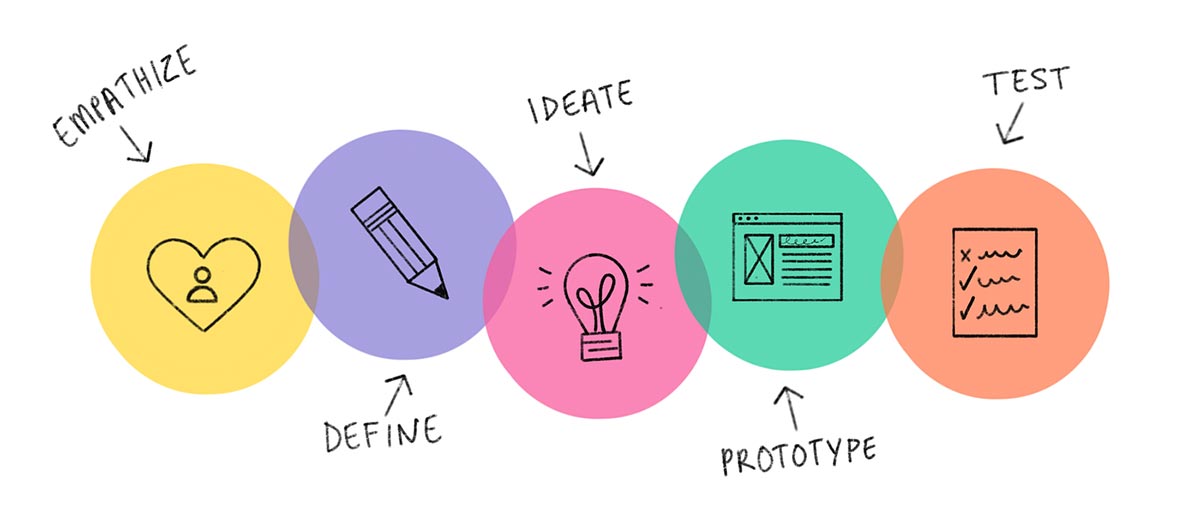As Vaibhav delved into the world of professionalism, he found himself fortunate to have a seasoned mentor in his Uncle, Sivaranjan, Vice President of a major corporation. Sivaranjan, a beacon of wisdom in the corporate realm, was always eager to impart lessons that transcended the confines of textbooks. Fueled by this guidance, Vaibhav felt more prepared and confident as he ventured into the professional world.
A year into his job, Vaibhav’s company nominated him for a 3-day Design Thinking Program. The first day left him perplexed, struggling to grasp the significance of Design Thinking in his professional journey. Seeking clarity, he turned to his Uncle Sivaranjan. In the last article, Sivaranjan gave an overview of Design Thinking to Vaibhav, and recognizing Vaibhav’s eagerness to grasp the essence of Design Thinking, decided to delve deeper into this transformative approach.
Sivaranjan: As Tim Brown, CEO of IDEO said, “Above all, think of life as a prototype. We can conduct experiments, make discoveries, and change our perspectives.”
Vaibhav: So, it’s about being open to change and learning?
Sivaranjan: Precisely! Design Thinking invites us to embrace the unknown, just as we would in the grand experiment of life. It encourages us to step into the shoes of those we design for, to empathize with and understand their needs. Life’s prototype becomes richer when we actively engage with it, just like Design Thinking enriches the design process.
Vaibhav: I see. So, it’s not just about finding solutions but also about evolving them.
Sivaranjan: Absolutely, Vaibhav. Design Thinking isn’t a one-size-fits-all solution. It’s a process that evolves, just like our prototypes in life. We ideate, prototype, and test – refining our solutions until we discover what truly works. It’s a dynamic, iterative approach that mirrors the continuous experimentation life offers.
Vaibhav: It’s like life is an ongoing project, and we are the designers learning as we go.
Sivaranjan: Spot on, Vaibhav! Life as a prototype allows room for growth, improvement, and unexpected discoveries. Design Thinking is the compass that guides us through this iterative process, turning challenges into opportunities and ensuring our solutions are as dynamic as the prototype of life itself.
Vaibhav: That’s a fascinating perspective, Uncle Siva. Life as a prototype indeed opens up a whole new way of thinking and approaching problems.
Sivaranjan: I’m glad you resonate with it, Vaibhav. Embrace the spirit of experimentation, and let Design Thinking be your guide in this ever-evolving prototype we call life.
Sivaranjan: Let’s deep dive into the Stanford Way of Design Thinking, why is it important, and the ‘famous five stages’ of design thinking.
Design Thinking: The Stanford Way

Vaibhav: Uncle, how did the concept of design thinking came into existence?
Herbert Simon, a cognitive scientist and Nobel laureate, introduced the idea of design as a way of thinking in his 1969 book, “The Sciences of the Artificial.” Simon’s ideas throughout the 1970s laid the foundation for design thinking principles we follow today. He emphasized concepts like rapid prototyping and testing through observation, which are crucial in modern design and entrepreneurial processes.
Vaibhav: Prototyping? That sounds advanced for the ’60s.
Sivaranjan: Indeed. Simon was ahead of his time. He spoke about prototyping as early as 1969. In “The Sciences of the Artificial,” he mentioned, “To understand them, the systems had to be constructed, and their behavior observed.” Simon recognized the power of building and observing systems, a concept that aligns with the core of design thinking we use today.
Simon’s insights laid the groundwork for the principles we now consider fundamental in design thinking. It’s a testament to the timeless nature of innovative thinking. Design Thinking originated as a process for crafting innovative technology and products. However, its scope has expanded significantly, surpassing boundaries to influence both private and public sectors, impacting business strategies, and even shaping personal projects globally.
Vaibhav: How did it become so widespread?
Sivaranjan: Well, one of the pioneers in popularizing Design Thinking was the design consulting firm IDEO. The methodology gained considerable traction, especially after Tim Brown, IDEO’s CEO, wrote an influential article in 2008 for the Harvard Business Review. In that piece, he highlighted the application of design thinking in diverse business environments, ranging from a California hospital to a Japanese bicycle company and the healthcare industry in India.
Vaibhav: That’s quite a leap from its origins!
Sivaranjan: Absolutely, Vaibhav. Design Thinking is versatile. Its adaptability and effectiveness in solving complex problems made it a go-to approach across various industries and sectors.
Vaibhav: Thanks for sharing that, Uncle Siva. It’s amazing to see the roots of design thinking reaching back decades.
Sivaranjan: Indeed, Vaibhav. It’s a rich history, and understanding these roots gives us a deeper appreciation for the evolution of design thinking over the years. Vaibhav, you will be amazed if I tell you that design thinking has its roots in Indian culture and Indian Knowledge System since ancient times. We will come to that in the next couple of sessions.
Vaibhav: Really, Uncle Siva? Design thinking in ancient Indian culture? That’s incredible! I had no idea it had such deep roots. I’m eager to learn more about how these ancient principles have influenced the way we approach design thinking today.
Sivaranjan: Definitely Vaibhav, we will understand that as well. For now, let’s delve into the importance of design thinking.
Importance of Design Thinking

Sivaranjan: Picture this, Vaibhav. Design thinking is like a Swiss Army knife for innovation, drawing from the designer’s toolkit to seamlessly integrate the needs of people, the possibilities of technology, and the requirements for business success.
Vaibhav: So, it’s about combining the best tools for the job?
Sivaranjan: Exactly! Imagine you’re building a house. You need the precision of an architect, the practicality of a carpenter, and the artistic touch of an interior designer. Design thinking assembles this diverse toolkit into a collaborative orchestra.
Vaibhav: That’s a unique way to look at it. But why is it so crucial for companies?
Sivaranjan: Well, Vaibhav, think of companies navigating a vast ocean of change. To stay afloat and ahead, they need the innovation wind in their sails. Design thinking becomes their compass, guiding cross-functional teams to not just understand user needs but to create solutions that address those needs effectively.
Vaibhav: So, it’s about sailing through the uncertainties with a well-guided ship?
Sivaranjan: Precisely! In the sea of business, where challenges are like waves, design thinking is the navigator ensuring the ship stays on course. It’s a process that thrives on collaboration and exploration.
Vaibhav: And how does it help with wicked problems?
Sivaranjan: Ah, wicked problems, the unruly sea monsters of the business world. Design thinking becomes our sword and shield. It’s like embarking on a quest to tame these monsters, with cross-functional teams wielding the tools of empathy, creativity, and iteration.
Vaibhav: So, it’s not just problem-solving; it’s a heroic adventure!
Sivaranjan: Absolutely! Design thinking transforms problem-solving into an epic journey, where the quest for creative solutions becomes the hero’s tale. It’s about facing the unknown with a toolkit of innovation, unraveling the mysteries of wicked problems, and emerging victorious.
Sivaranjan: You know, Vaibhav, Don Norman, a pioneer of user experience design, once highlighted why the designer’s way of thinking is so potent, especially in tackling complex problems. The designer’s mindset, with its emphasis on empathy, creativity, and iteration, becomes a beacon in the intricate landscape of challenges.
Vaibhav: It seems like the designer’s way of thinking is indeed a valuable compass in navigating the complexities of problem-solving.
Sivaranjan: Absolutely, Vaibhav. Embracing the designer’s mindset not only unlocks innovative solutions but also transforms every problem into an opportunity waiting to be explored. Design thinking is more than a process; it’s a philosophy that empowers us to face challenges with creativity, empathy, and the unwavering belief that every problem holds the potential for a potential resolution.
Vaibhav: Truly fascinating, Uncle. I can see why it’s such a powerful approach.
Sivaranjan: Let’s move to the next checkbox on the list.
Stages of Design Thinking

Sivaranjan: Vaibhav, Stanford’s Hasso Plattner Institute of Design, known as the d.school, is a trailblazer in design thinking. They follow a unique process with five phases: Empathize, Define, Ideate, Prototype, and Test.
Sivaranjan: In Empathize, teams conduct user research to truly understand the problem at hand. The key here is empathy. It allows designers to set aside assumptions, gaining profound insights into users and their needs.
Vaibhav: So, understanding the problem from the user’s perspective is the foundation.
Sivaranjan: Exactly, Vaibhav. Moving on, in the Define phase, the team analyzes their observations, synthesizes the information, and defines core problems through problem statements. This is where personas may come into play, keeping the focus on a human-centered approach.
Sivaranjan: In Ideating stage, teams challenge assumptions and brainstorm alternative perspectives on the problem. They generate innovative solutions to the defined problem statements.
Vaibhav: So, it’s about thinking outside the box and exploring diverse possibilities.
Sivaranjan: Yes. Now, the Prototype phase is experimental. The team creates scaled-down versions of the product or features to investigate ideas. It’s a hands-on approach to find the best solutions.
Sivaranjan: Yes, in Test, the team evaluates the prototypes with real users. It’s about validating if the solutions effectively address the problem. The test might reveal new insights, leading to refinements or even a revisit to the Define stage.
Vaibhav: So, it’s an iterative process where each stage contributes to the entire project.
Sivaranjan: Exactly, Vaibhav. These stages are more like different modes, working together to gain a deep understanding of users and craft the ideal solution or product. It’s a dynamic approach that ensures continual refinement based on real-world testing.
Vaibhav: Thank you, Uncle Siva, for walking me through this fascinating process. It’s inspiring to see how design thinking can reshape not just products but entire perspectives.
Sivaranjan: My pleasure, Vaibhav. As you delve deeper into the world of design thinking, remember that it’s not just a methodology; it’s a mindset. Embrace it, and you’ll find yourself on a perpetual journey of understanding, creating, and evolving – a journey that promises not just solutions, but a profound impact on the way we approach problems and possibilities.
Sivaranjan: Next, we will explore the Indian Knowledge System and its role in behaviour and development of future growth.
Vaibhav: That sounds intriguing, Uncle Siva. I’m eager to learn more about the insights it holds for our evolving world.
https://sdtp.co.uk/design-thinking-the-sdtp-way-dart/
https://www.wework.com/ideas/professional-development/creativity-culture/what-is-design-thinking
https://miro.medium.com/v2/resize:fit:1400/1*33khN9zpFCMWnF8pLqeVTQ.png
Written By: Dr. Jimmy Jain and Pavan Valluri
Edited By: Afreen Fatima
Society of Design Thinking Professionals









